University Report: Developing Safety, Health, and Wellbeing at Enersys
VerifiedAdded on 2021/04/17
|17
|2422
|30
Report
AI Summary
This report provides a detailed analysis of developing safety, health, and wellbeing within an industrial organization, specifically referencing Enersys. It begins by outlining conceptual frameworks, legal requirements related to risk management in the UK, and a logic model including input resources, activities, key outputs, and outcomes. The report then utilizes a SWOT analysis to evaluate strengths, weaknesses, opportunities, and threats. It delves into developing a strategic approach to intervention, including specific risk assessments such as manual handling, COSHH, DSE, and various analysis techniques like Fault Tree, Event Tree, HAZOPs, HTA, and FMEA. The report also emphasizes the importance of identifying key stakeholders, the role of top management in leading, and the application of felt-leadership to foster a strong safety culture. The analysis incorporates data from incident statistics, sickness absence monitoring, return to work status, and HSE check summaries to provide a comprehensive overview of the company's performance and areas for improvement. The report concludes by highlighting the importance of stakeholder management for the company's future growth and sustainability.
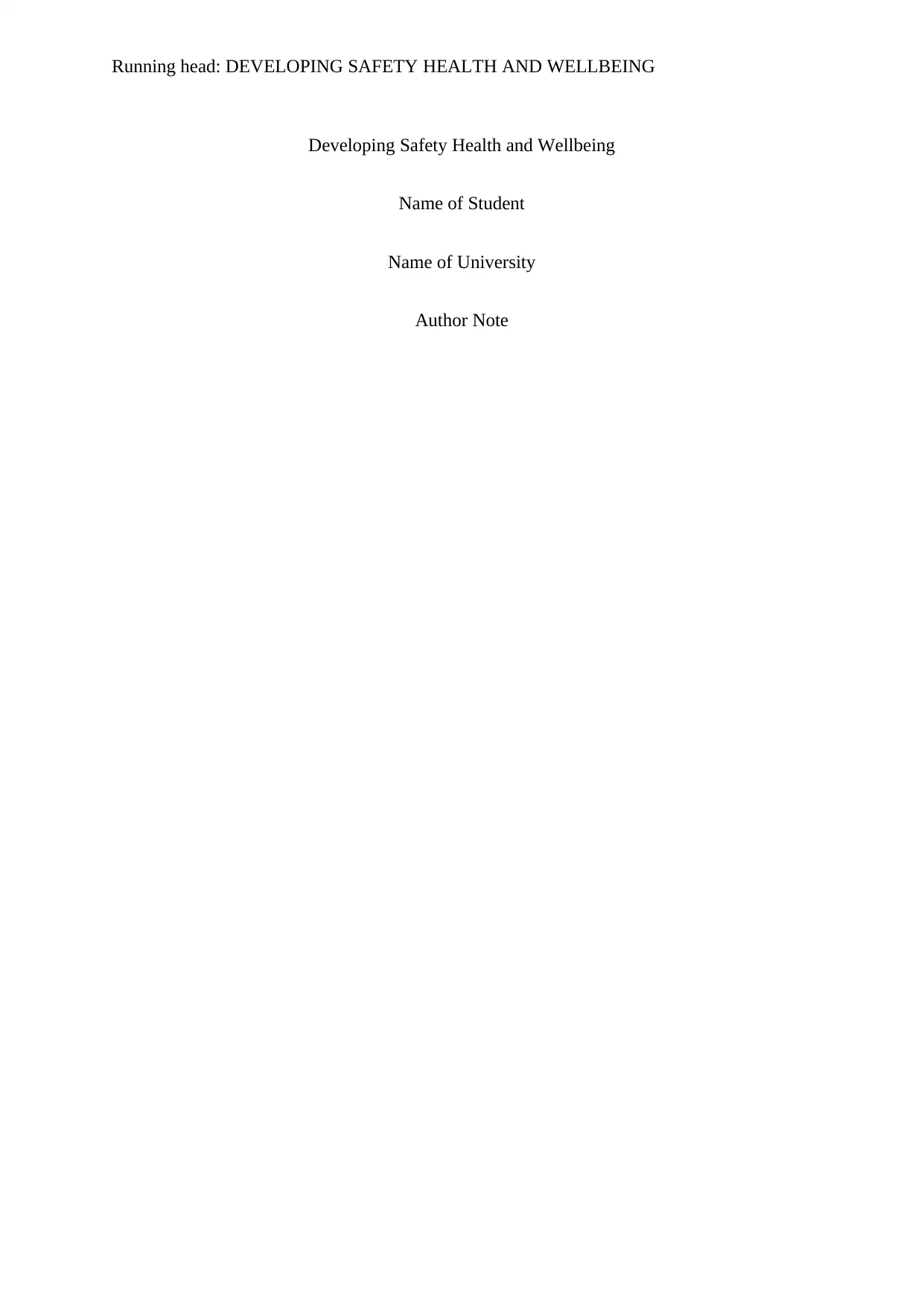
Running head: DEVELOPING SAFETY HEALTH AND WELLBEING
Developing Safety Health and Wellbeing
Name of Student
Name of University
Author Note
Developing Safety Health and Wellbeing
Name of Student
Name of University
Author Note
Paraphrase This Document
Need a fresh take? Get an instant paraphrase of this document with our AI Paraphraser
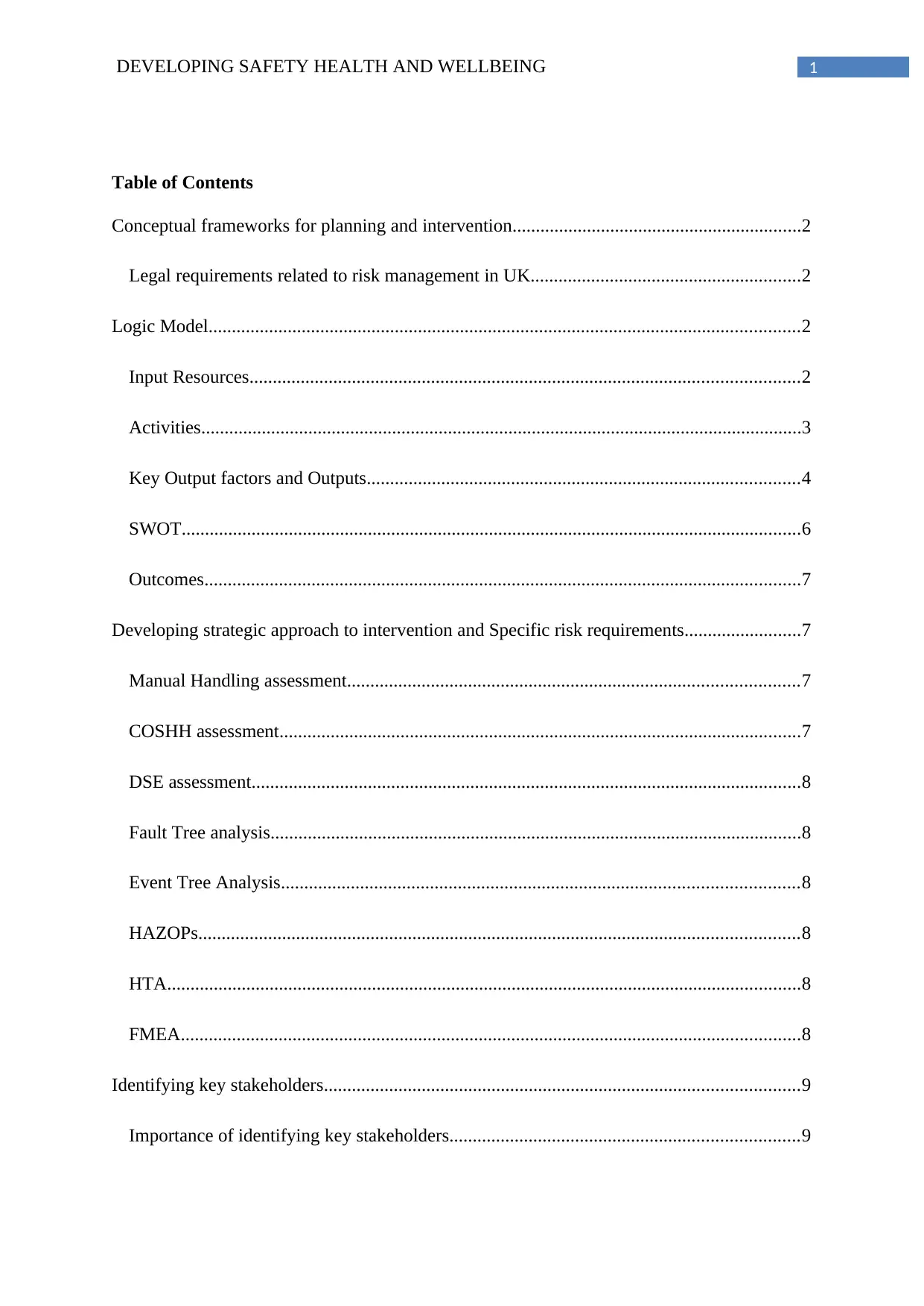
1DEVELOPING SAFETY HEALTH AND WELLBEING
Table of Contents
Conceptual frameworks for planning and intervention..............................................................2
Legal requirements related to risk management in UK..........................................................2
Logic Model...............................................................................................................................2
Input Resources......................................................................................................................2
Activities.................................................................................................................................3
Key Output factors and Outputs.............................................................................................4
SWOT.....................................................................................................................................6
Outcomes................................................................................................................................7
Developing strategic approach to intervention and Specific risk requirements.........................7
Manual Handling assessment.................................................................................................7
COSHH assessment................................................................................................................7
DSE assessment......................................................................................................................8
Fault Tree analysis..................................................................................................................8
Event Tree Analysis...............................................................................................................8
HAZOPs.................................................................................................................................8
HTA........................................................................................................................................8
FMEA.....................................................................................................................................8
Identifying key stakeholders......................................................................................................9
Importance of identifying key stakeholders...........................................................................9
Table of Contents
Conceptual frameworks for planning and intervention..............................................................2
Legal requirements related to risk management in UK..........................................................2
Logic Model...............................................................................................................................2
Input Resources......................................................................................................................2
Activities.................................................................................................................................3
Key Output factors and Outputs.............................................................................................4
SWOT.....................................................................................................................................6
Outcomes................................................................................................................................7
Developing strategic approach to intervention and Specific risk requirements.........................7
Manual Handling assessment.................................................................................................7
COSHH assessment................................................................................................................7
DSE assessment......................................................................................................................8
Fault Tree analysis..................................................................................................................8
Event Tree Analysis...............................................................................................................8
HAZOPs.................................................................................................................................8
HTA........................................................................................................................................8
FMEA.....................................................................................................................................8
Identifying key stakeholders......................................................................................................9
Importance of identifying key stakeholders...........................................................................9
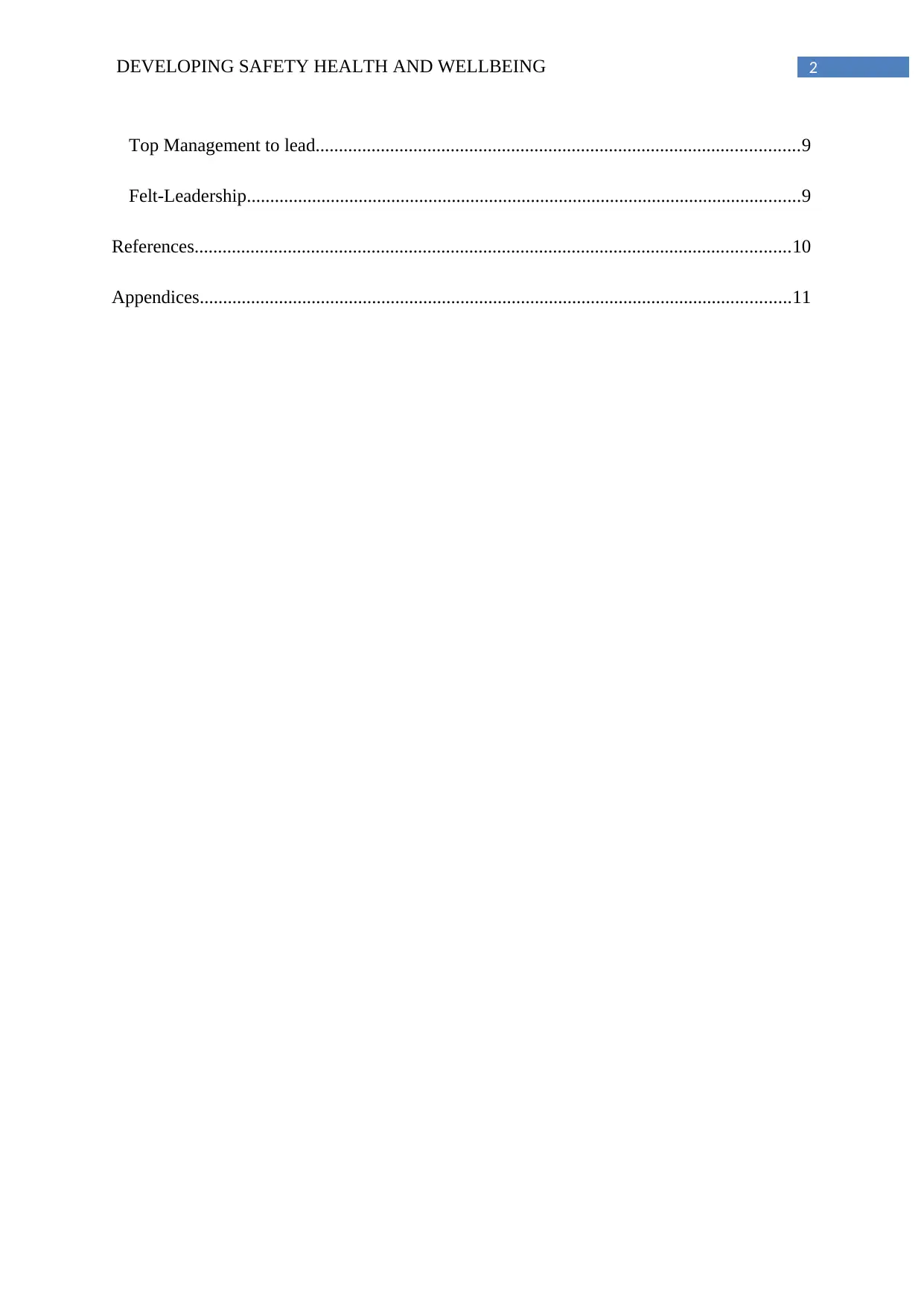
2DEVELOPING SAFETY HEALTH AND WELLBEING
Top Management to lead........................................................................................................9
Felt-Leadership.......................................................................................................................9
References................................................................................................................................10
Appendices...............................................................................................................................11
Top Management to lead........................................................................................................9
Felt-Leadership.......................................................................................................................9
References................................................................................................................................10
Appendices...............................................................................................................................11
⊘ This is a preview!⊘
Do you want full access?
Subscribe today to unlock all pages.

Trusted by 1+ million students worldwide
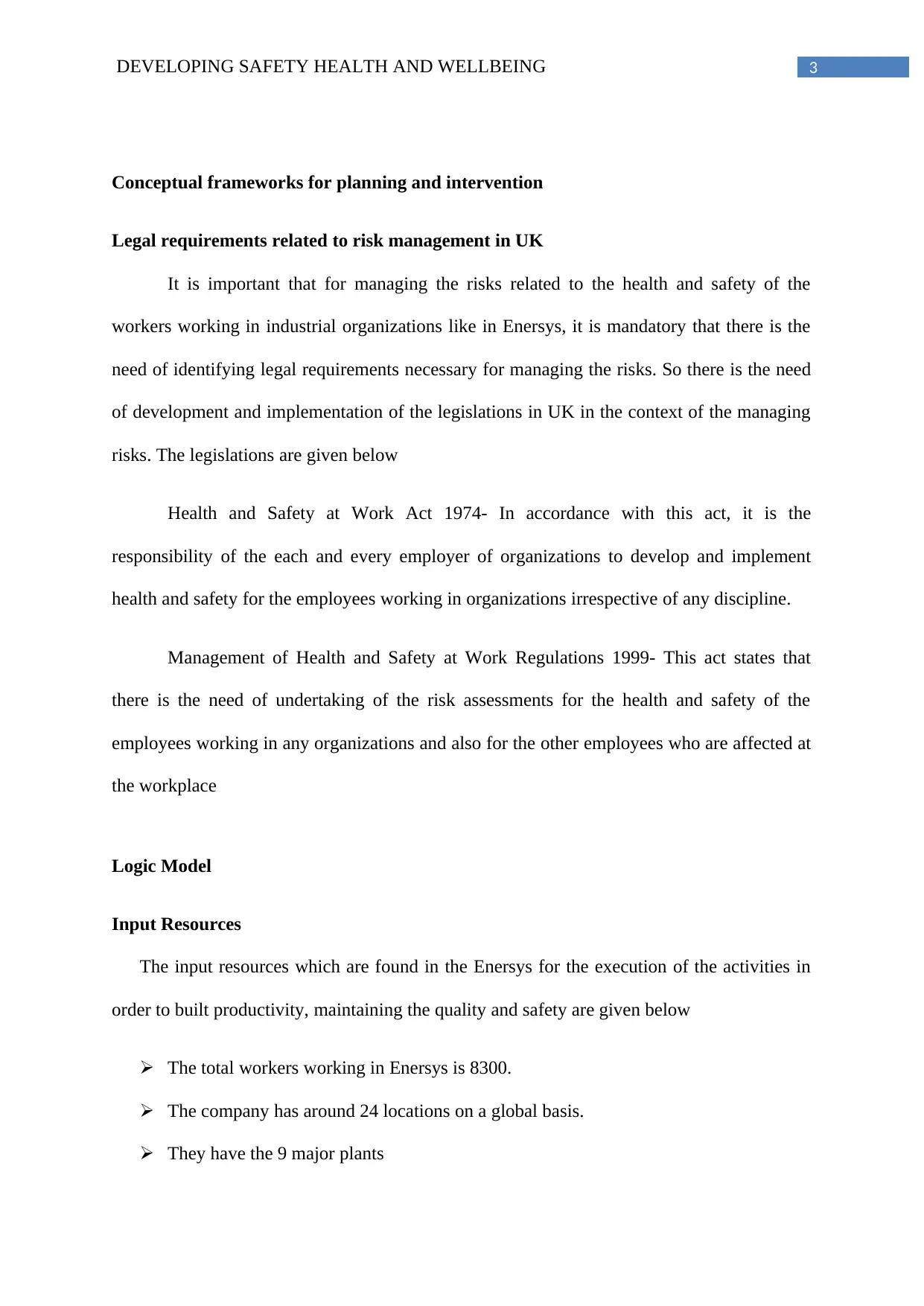
3DEVELOPING SAFETY HEALTH AND WELLBEING
Conceptual frameworks for planning and intervention
Legal requirements related to risk management in UK
It is important that for managing the risks related to the health and safety of the
workers working in industrial organizations like in Enersys, it is mandatory that there is the
need of identifying legal requirements necessary for managing the risks. So there is the need
of development and implementation of the legislations in UK in the context of the managing
risks. The legislations are given below
Health and Safety at Work Act 1974- In accordance with this act, it is the
responsibility of the each and every employer of organizations to develop and implement
health and safety for the employees working in organizations irrespective of any discipline.
Management of Health and Safety at Work Regulations 1999- This act states that
there is the need of undertaking of the risk assessments for the health and safety of the
employees working in any organizations and also for the other employees who are affected at
the workplace
Logic Model
Input Resources
The input resources which are found in the Enersys for the execution of the activities in
order to built productivity, maintaining the quality and safety are given below
The total workers working in Enersys is 8300.
The company has around 24 locations on a global basis.
They have the 9 major plants
Conceptual frameworks for planning and intervention
Legal requirements related to risk management in UK
It is important that for managing the risks related to the health and safety of the
workers working in industrial organizations like in Enersys, it is mandatory that there is the
need of identifying legal requirements necessary for managing the risks. So there is the need
of development and implementation of the legislations in UK in the context of the managing
risks. The legislations are given below
Health and Safety at Work Act 1974- In accordance with this act, it is the
responsibility of the each and every employer of organizations to develop and implement
health and safety for the employees working in organizations irrespective of any discipline.
Management of Health and Safety at Work Regulations 1999- This act states that
there is the need of undertaking of the risk assessments for the health and safety of the
employees working in any organizations and also for the other employees who are affected at
the workplace
Logic Model
Input Resources
The input resources which are found in the Enersys for the execution of the activities in
order to built productivity, maintaining the quality and safety are given below
The total workers working in Enersys is 8300.
The company has around 24 locations on a global basis.
They have the 9 major plants
Paraphrase This Document
Need a fresh take? Get an instant paraphrase of this document with our AI Paraphraser
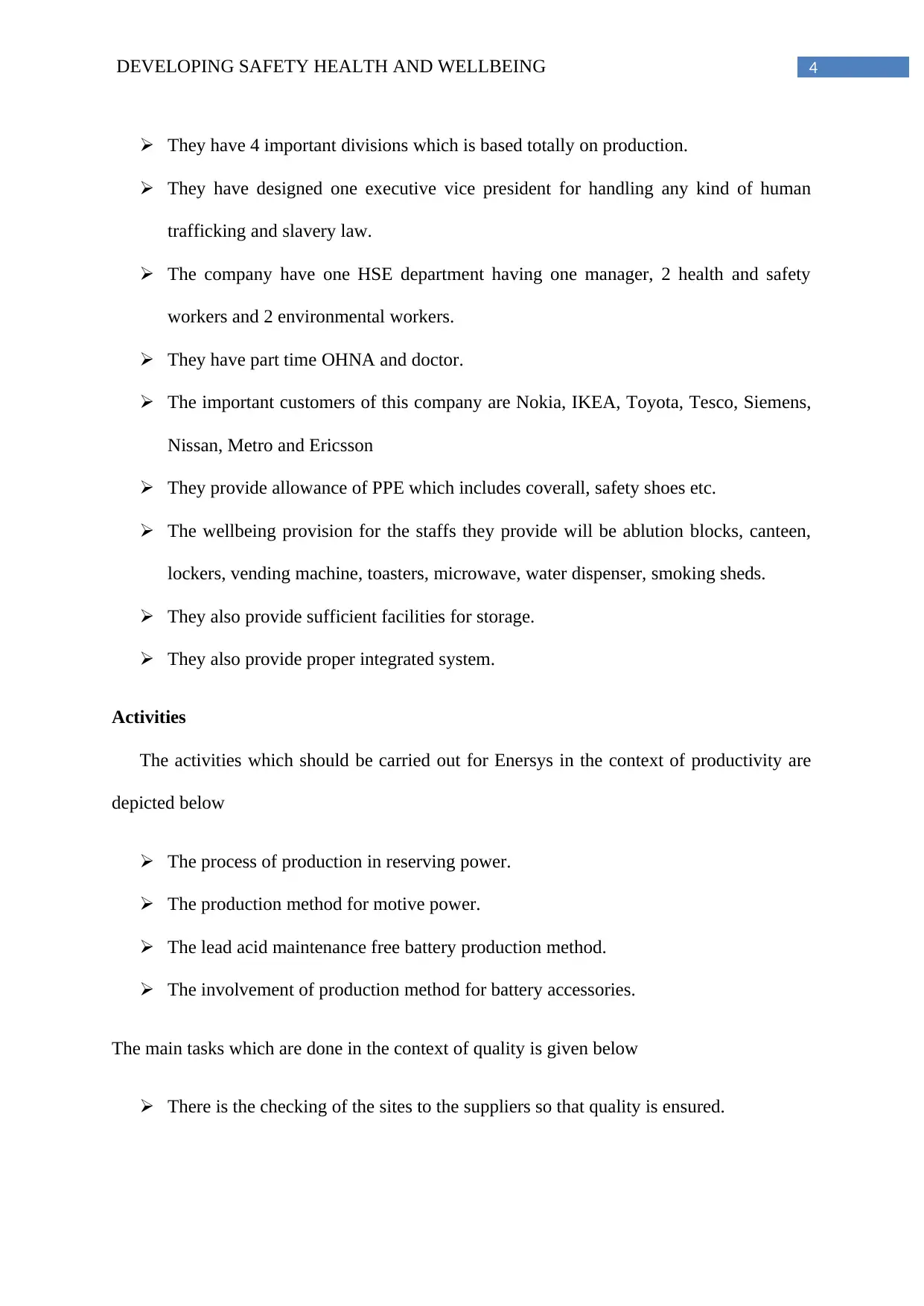
4DEVELOPING SAFETY HEALTH AND WELLBEING
They have 4 important divisions which is based totally on production.
They have designed one executive vice president for handling any kind of human
trafficking and slavery law.
The company have one HSE department having one manager, 2 health and safety
workers and 2 environmental workers.
They have part time OHNA and doctor.
The important customers of this company are Nokia, IKEA, Toyota, Tesco, Siemens,
Nissan, Metro and Ericsson
They provide allowance of PPE which includes coverall, safety shoes etc.
The wellbeing provision for the staffs they provide will be ablution blocks, canteen,
lockers, vending machine, toasters, microwave, water dispenser, smoking sheds.
They also provide sufficient facilities for storage.
They also provide proper integrated system.
Activities
The activities which should be carried out for Enersys in the context of productivity are
depicted below
The process of production in reserving power.
The production method for motive power.
The lead acid maintenance free battery production method.
The involvement of production method for battery accessories.
The main tasks which are done in the context of quality is given below
There is the checking of the sites to the suppliers so that quality is ensured.
They have 4 important divisions which is based totally on production.
They have designed one executive vice president for handling any kind of human
trafficking and slavery law.
The company have one HSE department having one manager, 2 health and safety
workers and 2 environmental workers.
They have part time OHNA and doctor.
The important customers of this company are Nokia, IKEA, Toyota, Tesco, Siemens,
Nissan, Metro and Ericsson
They provide allowance of PPE which includes coverall, safety shoes etc.
The wellbeing provision for the staffs they provide will be ablution blocks, canteen,
lockers, vending machine, toasters, microwave, water dispenser, smoking sheds.
They also provide sufficient facilities for storage.
They also provide proper integrated system.
Activities
The activities which should be carried out for Enersys in the context of productivity are
depicted below
The process of production in reserving power.
The production method for motive power.
The lead acid maintenance free battery production method.
The involvement of production method for battery accessories.
The main tasks which are done in the context of quality is given below
There is the checking of the sites to the suppliers so that quality is ensured.
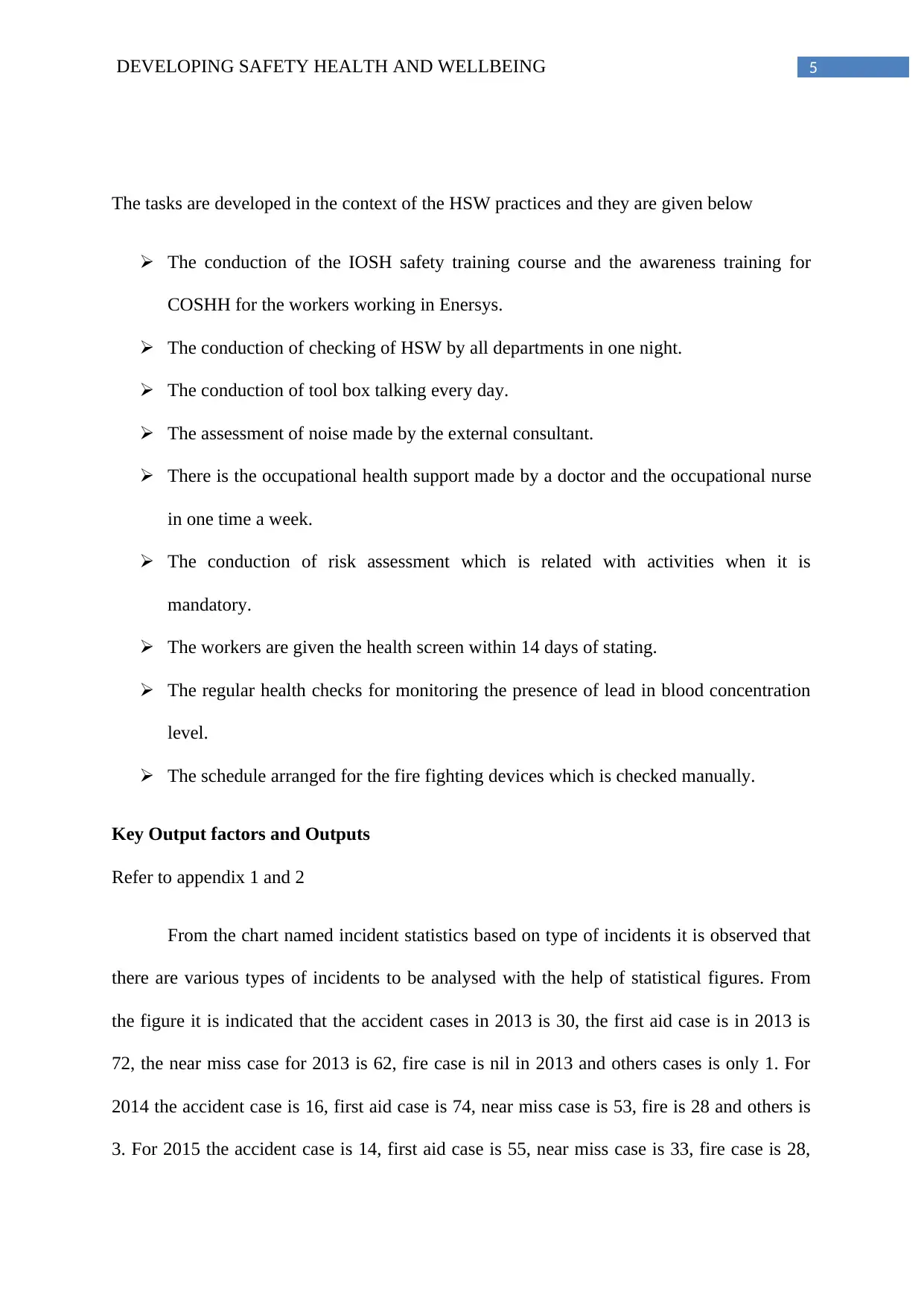
5DEVELOPING SAFETY HEALTH AND WELLBEING
The tasks are developed in the context of the HSW practices and they are given below
The conduction of the IOSH safety training course and the awareness training for
COSHH for the workers working in Enersys.
The conduction of checking of HSW by all departments in one night.
The conduction of tool box talking every day.
The assessment of noise made by the external consultant.
There is the occupational health support made by a doctor and the occupational nurse
in one time a week.
The conduction of risk assessment which is related with activities when it is
mandatory.
The workers are given the health screen within 14 days of stating.
The regular health checks for monitoring the presence of lead in blood concentration
level.
The schedule arranged for the fire fighting devices which is checked manually.
Key Output factors and Outputs
Refer to appendix 1 and 2
From the chart named incident statistics based on type of incidents it is observed that
there are various types of incidents to be analysed with the help of statistical figures. From
the figure it is indicated that the accident cases in 2013 is 30, the first aid case is in 2013 is
72, the near miss case for 2013 is 62, fire case is nil in 2013 and others cases is only 1. For
2014 the accident case is 16, first aid case is 74, near miss case is 53, fire is 28 and others is
3. For 2015 the accident case is 14, first aid case is 55, near miss case is 33, fire case is 28,
The tasks are developed in the context of the HSW practices and they are given below
The conduction of the IOSH safety training course and the awareness training for
COSHH for the workers working in Enersys.
The conduction of checking of HSW by all departments in one night.
The conduction of tool box talking every day.
The assessment of noise made by the external consultant.
There is the occupational health support made by a doctor and the occupational nurse
in one time a week.
The conduction of risk assessment which is related with activities when it is
mandatory.
The workers are given the health screen within 14 days of stating.
The regular health checks for monitoring the presence of lead in blood concentration
level.
The schedule arranged for the fire fighting devices which is checked manually.
Key Output factors and Outputs
Refer to appendix 1 and 2
From the chart named incident statistics based on type of incidents it is observed that
there are various types of incidents to be analysed with the help of statistical figures. From
the figure it is indicated that the accident cases in 2013 is 30, the first aid case is in 2013 is
72, the near miss case for 2013 is 62, fire case is nil in 2013 and others cases is only 1. For
2014 the accident case is 16, first aid case is 74, near miss case is 53, fire is 28 and others is
3. For 2015 the accident case is 14, first aid case is 55, near miss case is 33, fire case is 28,
⊘ This is a preview!⊘
Do you want full access?
Subscribe today to unlock all pages.

Trusted by 1+ million students worldwide
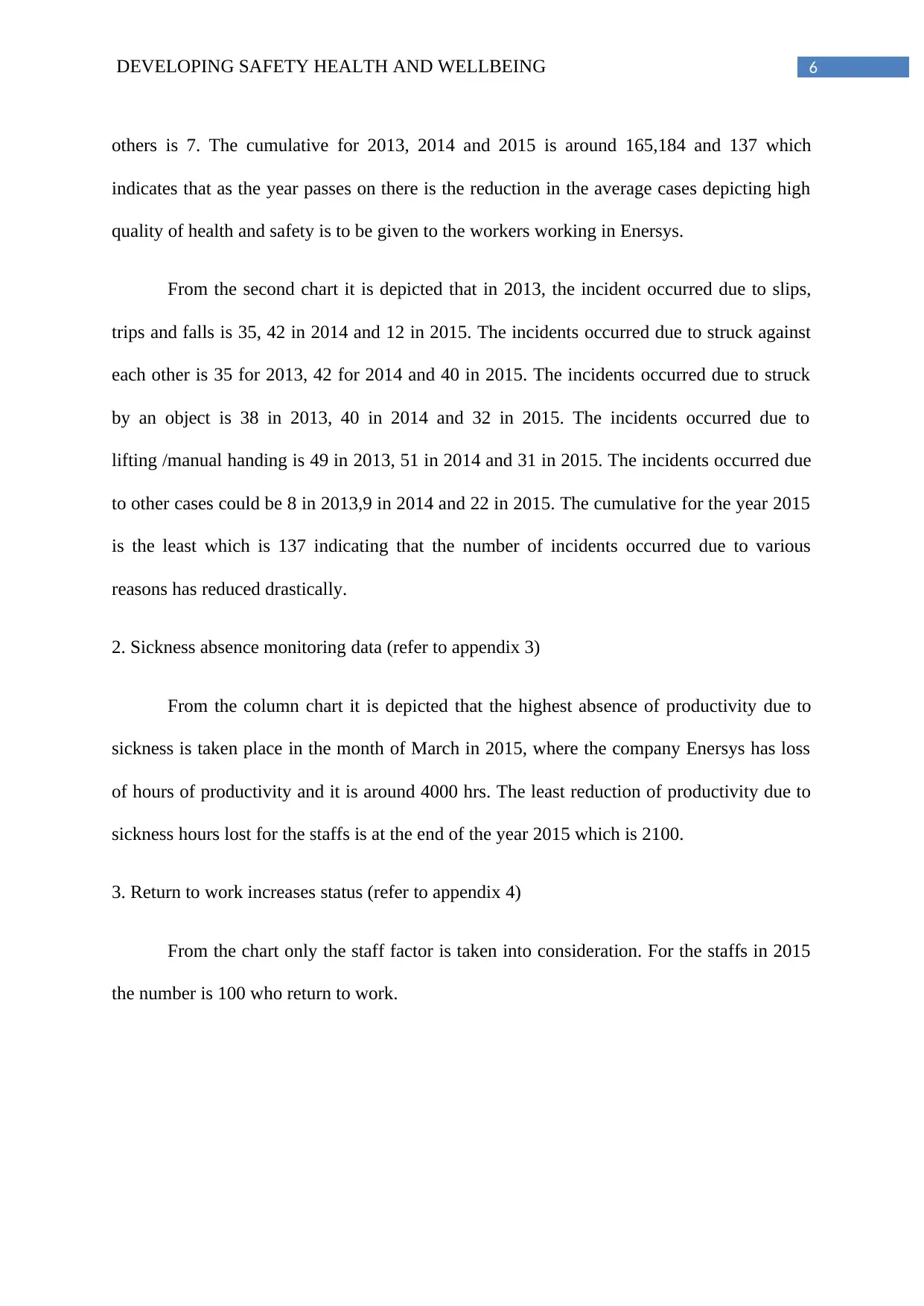
6DEVELOPING SAFETY HEALTH AND WELLBEING
others is 7. The cumulative for 2013, 2014 and 2015 is around 165,184 and 137 which
indicates that as the year passes on there is the reduction in the average cases depicting high
quality of health and safety is to be given to the workers working in Enersys.
From the second chart it is depicted that in 2013, the incident occurred due to slips,
trips and falls is 35, 42 in 2014 and 12 in 2015. The incidents occurred due to struck against
each other is 35 for 2013, 42 for 2014 and 40 in 2015. The incidents occurred due to struck
by an object is 38 in 2013, 40 in 2014 and 32 in 2015. The incidents occurred due to
lifting /manual handing is 49 in 2013, 51 in 2014 and 31 in 2015. The incidents occurred due
to other cases could be 8 in 2013,9 in 2014 and 22 in 2015. The cumulative for the year 2015
is the least which is 137 indicating that the number of incidents occurred due to various
reasons has reduced drastically.
2. Sickness absence monitoring data (refer to appendix 3)
From the column chart it is depicted that the highest absence of productivity due to
sickness is taken place in the month of March in 2015, where the company Enersys has loss
of hours of productivity and it is around 4000 hrs. The least reduction of productivity due to
sickness hours lost for the staffs is at the end of the year 2015 which is 2100.
3. Return to work increases status (refer to appendix 4)
From the chart only the staff factor is taken into consideration. For the staffs in 2015
the number is 100 who return to work.
others is 7. The cumulative for 2013, 2014 and 2015 is around 165,184 and 137 which
indicates that as the year passes on there is the reduction in the average cases depicting high
quality of health and safety is to be given to the workers working in Enersys.
From the second chart it is depicted that in 2013, the incident occurred due to slips,
trips and falls is 35, 42 in 2014 and 12 in 2015. The incidents occurred due to struck against
each other is 35 for 2013, 42 for 2014 and 40 in 2015. The incidents occurred due to struck
by an object is 38 in 2013, 40 in 2014 and 32 in 2015. The incidents occurred due to
lifting /manual handing is 49 in 2013, 51 in 2014 and 31 in 2015. The incidents occurred due
to other cases could be 8 in 2013,9 in 2014 and 22 in 2015. The cumulative for the year 2015
is the least which is 137 indicating that the number of incidents occurred due to various
reasons has reduced drastically.
2. Sickness absence monitoring data (refer to appendix 3)
From the column chart it is depicted that the highest absence of productivity due to
sickness is taken place in the month of March in 2015, where the company Enersys has loss
of hours of productivity and it is around 4000 hrs. The least reduction of productivity due to
sickness hours lost for the staffs is at the end of the year 2015 which is 2100.
3. Return to work increases status (refer to appendix 4)
From the chart only the staff factor is taken into consideration. For the staffs in 2015
the number is 100 who return to work.
Paraphrase This Document
Need a fresh take? Get an instant paraphrase of this document with our AI Paraphraser
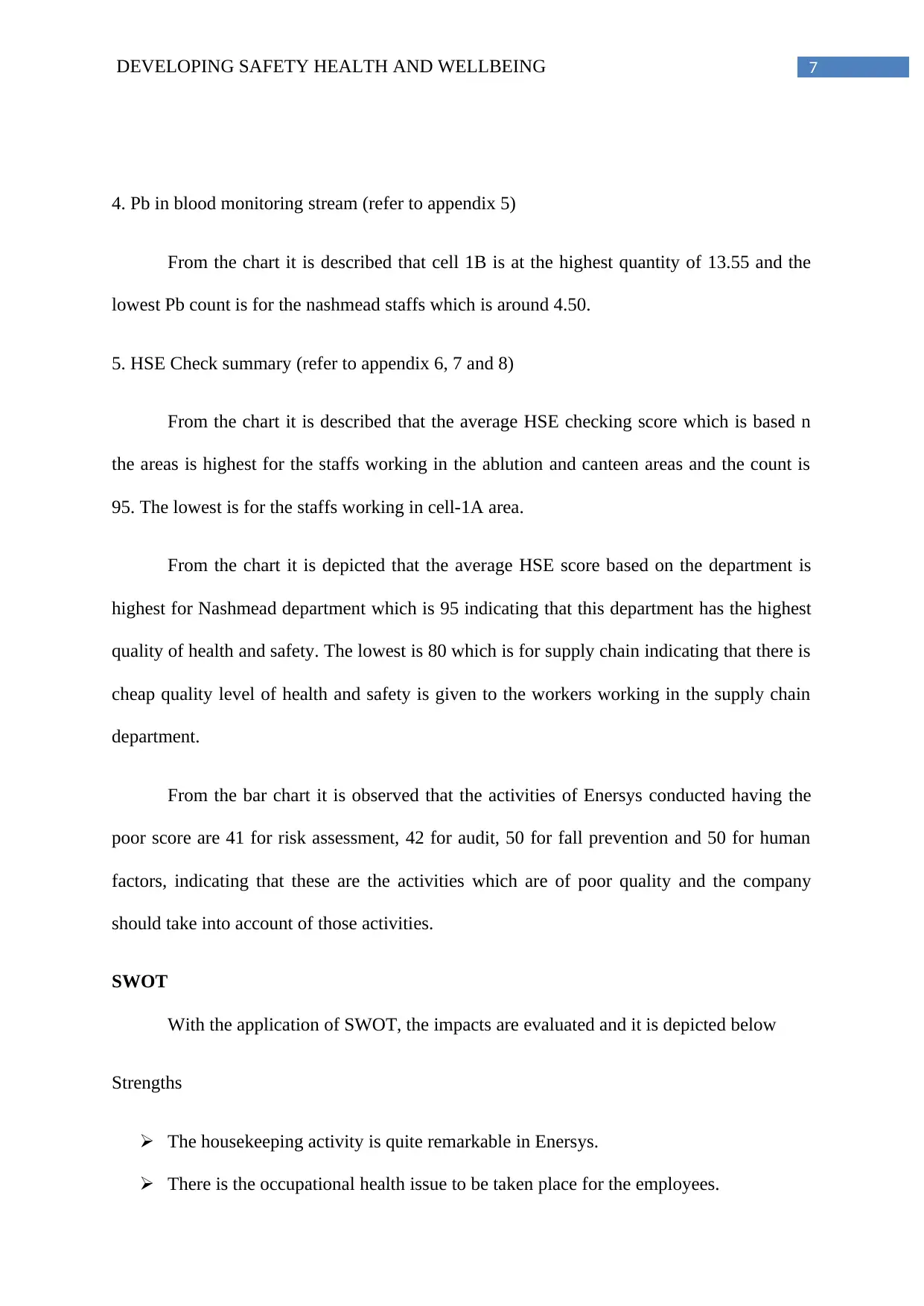
7DEVELOPING SAFETY HEALTH AND WELLBEING
4. Pb in blood monitoring stream (refer to appendix 5)
From the chart it is described that cell 1B is at the highest quantity of 13.55 and the
lowest Pb count is for the nashmead staffs which is around 4.50.
5. HSE Check summary (refer to appendix 6, 7 and 8)
From the chart it is described that the average HSE checking score which is based n
the areas is highest for the staffs working in the ablution and canteen areas and the count is
95. The lowest is for the staffs working in cell-1A area.
From the chart it is depicted that the average HSE score based on the department is
highest for Nashmead department which is 95 indicating that this department has the highest
quality of health and safety. The lowest is 80 which is for supply chain indicating that there is
cheap quality level of health and safety is given to the workers working in the supply chain
department.
From the bar chart it is observed that the activities of Enersys conducted having the
poor score are 41 for risk assessment, 42 for audit, 50 for fall prevention and 50 for human
factors, indicating that these are the activities which are of poor quality and the company
should take into account of those activities.
SWOT
With the application of SWOT, the impacts are evaluated and it is depicted below
Strengths
The housekeeping activity is quite remarkable in Enersys.
There is the occupational health issue to be taken place for the employees.
4. Pb in blood monitoring stream (refer to appendix 5)
From the chart it is described that cell 1B is at the highest quantity of 13.55 and the
lowest Pb count is for the nashmead staffs which is around 4.50.
5. HSE Check summary (refer to appendix 6, 7 and 8)
From the chart it is described that the average HSE checking score which is based n
the areas is highest for the staffs working in the ablution and canteen areas and the count is
95. The lowest is for the staffs working in cell-1A area.
From the chart it is depicted that the average HSE score based on the department is
highest for Nashmead department which is 95 indicating that this department has the highest
quality of health and safety. The lowest is 80 which is for supply chain indicating that there is
cheap quality level of health and safety is given to the workers working in the supply chain
department.
From the bar chart it is observed that the activities of Enersys conducted having the
poor score are 41 for risk assessment, 42 for audit, 50 for fall prevention and 50 for human
factors, indicating that these are the activities which are of poor quality and the company
should take into account of those activities.
SWOT
With the application of SWOT, the impacts are evaluated and it is depicted below
Strengths
The housekeeping activity is quite remarkable in Enersys.
There is the occupational health issue to be taken place for the employees.
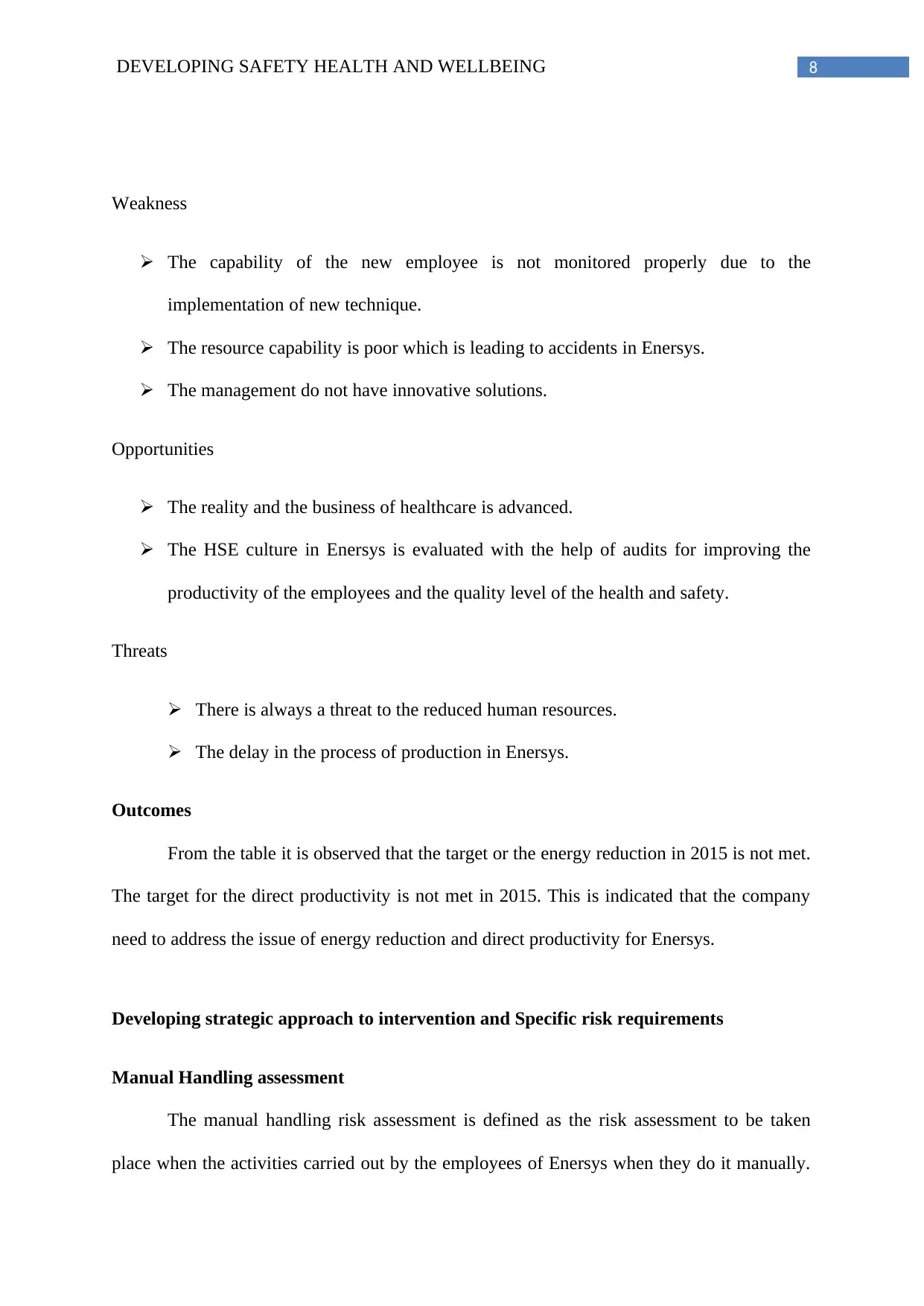
8DEVELOPING SAFETY HEALTH AND WELLBEING
Weakness
The capability of the new employee is not monitored properly due to the
implementation of new technique.
The resource capability is poor which is leading to accidents in Enersys.
The management do not have innovative solutions.
Opportunities
The reality and the business of healthcare is advanced.
The HSE culture in Enersys is evaluated with the help of audits for improving the
productivity of the employees and the quality level of the health and safety.
Threats
There is always a threat to the reduced human resources.
The delay in the process of production in Enersys.
Outcomes
From the table it is observed that the target or the energy reduction in 2015 is not met.
The target for the direct productivity is not met in 2015. This is indicated that the company
need to address the issue of energy reduction and direct productivity for Enersys.
Developing strategic approach to intervention and Specific risk requirements
Manual Handling assessment
The manual handling risk assessment is defined as the risk assessment to be taken
place when the activities carried out by the employees of Enersys when they do it manually.
Weakness
The capability of the new employee is not monitored properly due to the
implementation of new technique.
The resource capability is poor which is leading to accidents in Enersys.
The management do not have innovative solutions.
Opportunities
The reality and the business of healthcare is advanced.
The HSE culture in Enersys is evaluated with the help of audits for improving the
productivity of the employees and the quality level of the health and safety.
Threats
There is always a threat to the reduced human resources.
The delay in the process of production in Enersys.
Outcomes
From the table it is observed that the target or the energy reduction in 2015 is not met.
The target for the direct productivity is not met in 2015. This is indicated that the company
need to address the issue of energy reduction and direct productivity for Enersys.
Developing strategic approach to intervention and Specific risk requirements
Manual Handling assessment
The manual handling risk assessment is defined as the risk assessment to be taken
place when the activities carried out by the employees of Enersys when they do it manually.
⊘ This is a preview!⊘
Do you want full access?
Subscribe today to unlock all pages.

Trusted by 1+ million students worldwide
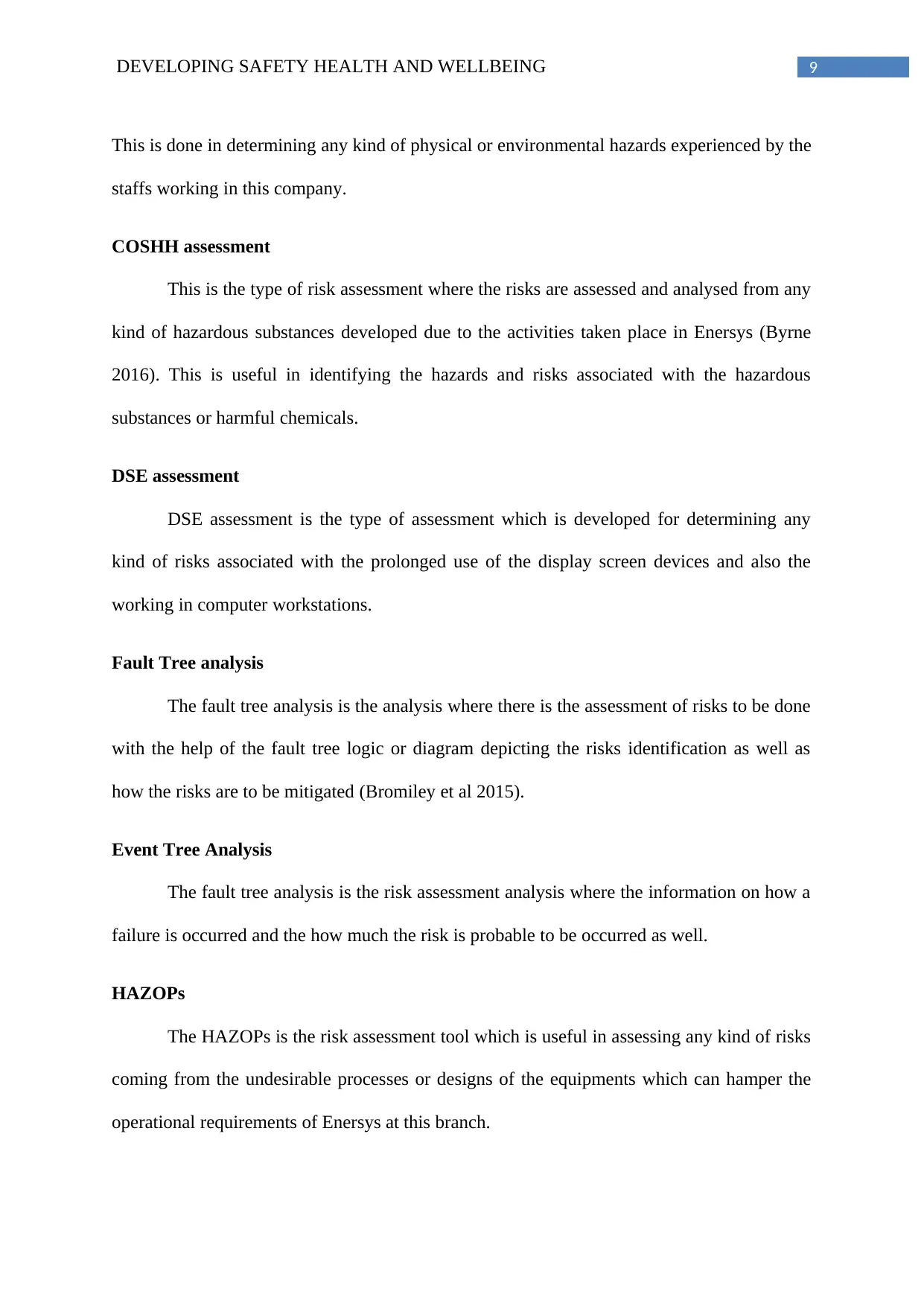
9DEVELOPING SAFETY HEALTH AND WELLBEING
This is done in determining any kind of physical or environmental hazards experienced by the
staffs working in this company.
COSHH assessment
This is the type of risk assessment where the risks are assessed and analysed from any
kind of hazardous substances developed due to the activities taken place in Enersys (Byrne
2016). This is useful in identifying the hazards and risks associated with the hazardous
substances or harmful chemicals.
DSE assessment
DSE assessment is the type of assessment which is developed for determining any
kind of risks associated with the prolonged use of the display screen devices and also the
working in computer workstations.
Fault Tree analysis
The fault tree analysis is the analysis where there is the assessment of risks to be done
with the help of the fault tree logic or diagram depicting the risks identification as well as
how the risks are to be mitigated (Bromiley et al 2015).
Event Tree Analysis
The fault tree analysis is the risk assessment analysis where the information on how a
failure is occurred and the how much the risk is probable to be occurred as well.
HAZOPs
The HAZOPs is the risk assessment tool which is useful in assessing any kind of risks
coming from the undesirable processes or designs of the equipments which can hamper the
operational requirements of Enersys at this branch.
This is done in determining any kind of physical or environmental hazards experienced by the
staffs working in this company.
COSHH assessment
This is the type of risk assessment where the risks are assessed and analysed from any
kind of hazardous substances developed due to the activities taken place in Enersys (Byrne
2016). This is useful in identifying the hazards and risks associated with the hazardous
substances or harmful chemicals.
DSE assessment
DSE assessment is the type of assessment which is developed for determining any
kind of risks associated with the prolonged use of the display screen devices and also the
working in computer workstations.
Fault Tree analysis
The fault tree analysis is the analysis where there is the assessment of risks to be done
with the help of the fault tree logic or diagram depicting the risks identification as well as
how the risks are to be mitigated (Bromiley et al 2015).
Event Tree Analysis
The fault tree analysis is the risk assessment analysis where the information on how a
failure is occurred and the how much the risk is probable to be occurred as well.
HAZOPs
The HAZOPs is the risk assessment tool which is useful in assessing any kind of risks
coming from the undesirable processes or designs of the equipments which can hamper the
operational requirements of Enersys at this branch.
Paraphrase This Document
Need a fresh take? Get an instant paraphrase of this document with our AI Paraphraser
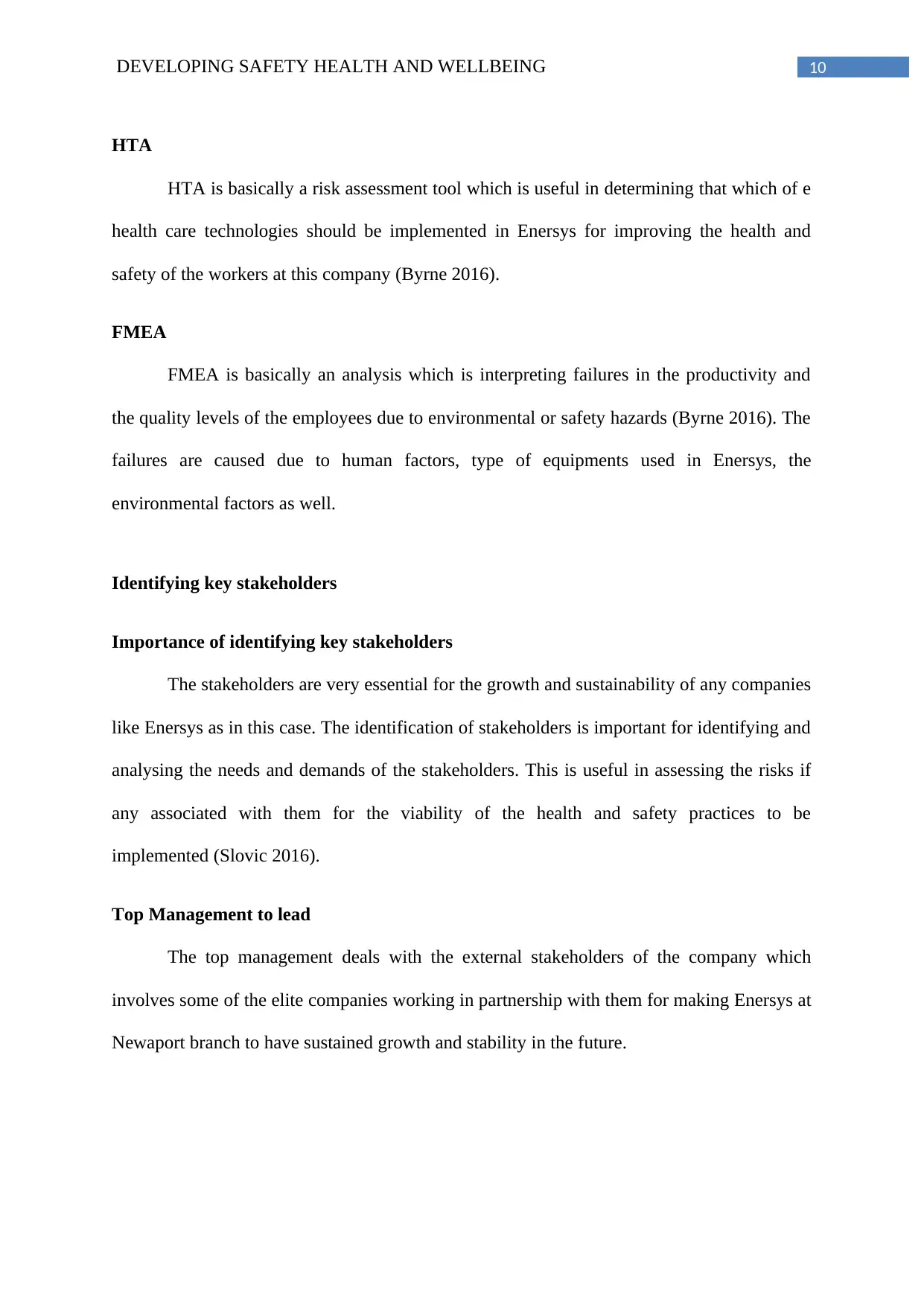
10DEVELOPING SAFETY HEALTH AND WELLBEING
HTA
HTA is basically a risk assessment tool which is useful in determining that which of e
health care technologies should be implemented in Enersys for improving the health and
safety of the workers at this company (Byrne 2016).
FMEA
FMEA is basically an analysis which is interpreting failures in the productivity and
the quality levels of the employees due to environmental or safety hazards (Byrne 2016). The
failures are caused due to human factors, type of equipments used in Enersys, the
environmental factors as well.
Identifying key stakeholders
Importance of identifying key stakeholders
The stakeholders are very essential for the growth and sustainability of any companies
like Enersys as in this case. The identification of stakeholders is important for identifying and
analysing the needs and demands of the stakeholders. This is useful in assessing the risks if
any associated with them for the viability of the health and safety practices to be
implemented (Slovic 2016).
Top Management to lead
The top management deals with the external stakeholders of the company which
involves some of the elite companies working in partnership with them for making Enersys at
Newaport branch to have sustained growth and stability in the future.
HTA
HTA is basically a risk assessment tool which is useful in determining that which of e
health care technologies should be implemented in Enersys for improving the health and
safety of the workers at this company (Byrne 2016).
FMEA
FMEA is basically an analysis which is interpreting failures in the productivity and
the quality levels of the employees due to environmental or safety hazards (Byrne 2016). The
failures are caused due to human factors, type of equipments used in Enersys, the
environmental factors as well.
Identifying key stakeholders
Importance of identifying key stakeholders
The stakeholders are very essential for the growth and sustainability of any companies
like Enersys as in this case. The identification of stakeholders is important for identifying and
analysing the needs and demands of the stakeholders. This is useful in assessing the risks if
any associated with them for the viability of the health and safety practices to be
implemented (Slovic 2016).
Top Management to lead
The top management deals with the external stakeholders of the company which
involves some of the elite companies working in partnership with them for making Enersys at
Newaport branch to have sustained growth and stability in the future.
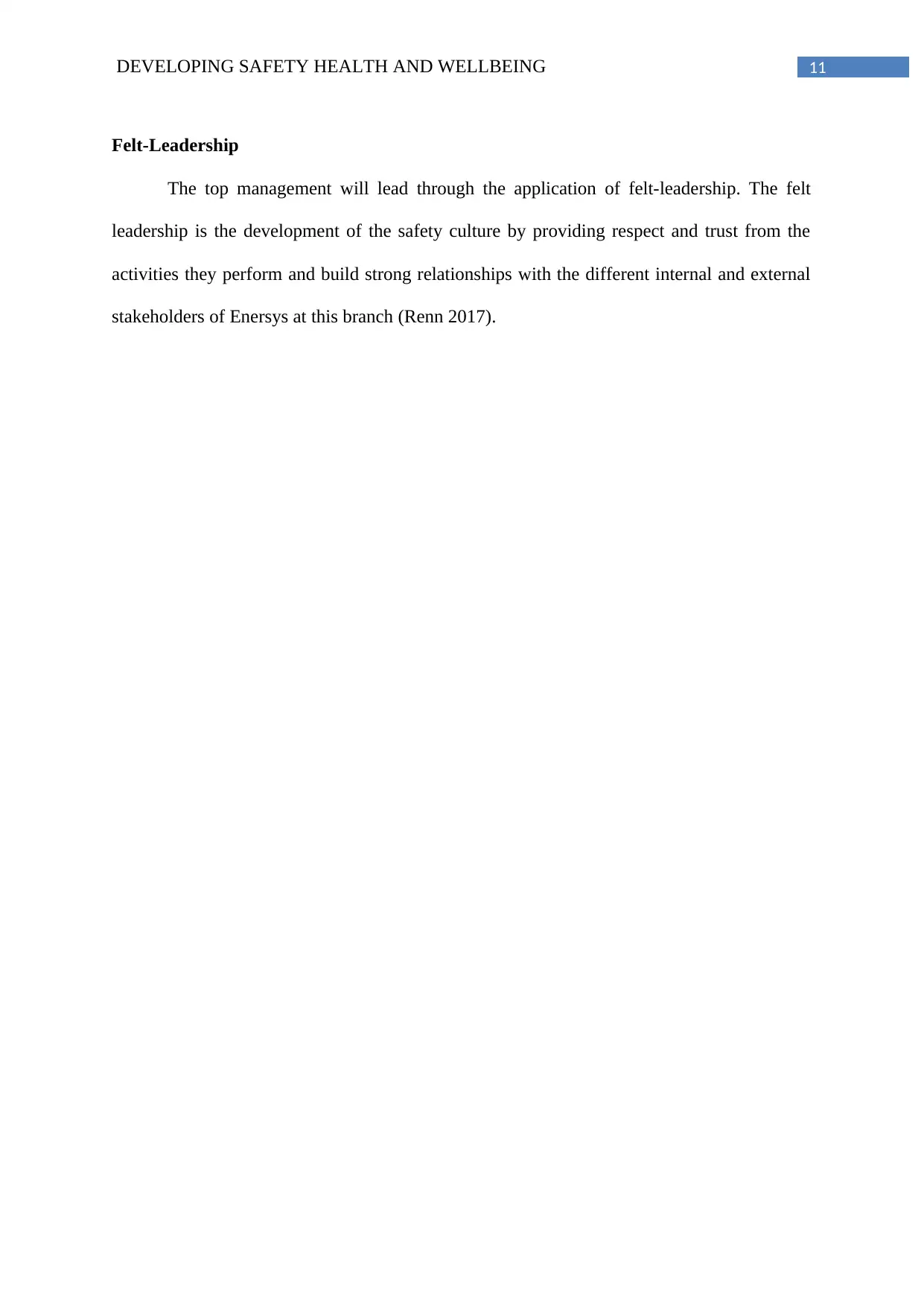
11DEVELOPING SAFETY HEALTH AND WELLBEING
Felt-Leadership
The top management will lead through the application of felt-leadership. The felt
leadership is the development of the safety culture by providing respect and trust from the
activities they perform and build strong relationships with the different internal and external
stakeholders of Enersys at this branch (Renn 2017).
Felt-Leadership
The top management will lead through the application of felt-leadership. The felt
leadership is the development of the safety culture by providing respect and trust from the
activities they perform and build strong relationships with the different internal and external
stakeholders of Enersys at this branch (Renn 2017).
⊘ This is a preview!⊘
Do you want full access?
Subscribe today to unlock all pages.

Trusted by 1+ million students worldwide
1 out of 17
Related Documents
Your All-in-One AI-Powered Toolkit for Academic Success.
+13062052269
info@desklib.com
Available 24*7 on WhatsApp / Email
![[object Object]](/_next/static/media/star-bottom.7253800d.svg)
Unlock your academic potential
Copyright © 2020–2025 A2Z Services. All Rights Reserved. Developed and managed by ZUCOL.





